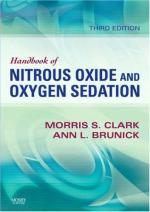|
This section contains 993 words (approx. 4 pages at 300 words per page) |

|
Overview
Nitrous oxide (NYE-truss OX-side) is also known as dinitrogen oxide, dinitrogen monoxide, nitrogen monoxide, and laughing gas. It is a colorless, nonflammable gas with a sweet odor. Its common name of laughing gas is derived from the fact that it produces a sense of light-headedness when inhaled. The gas is widely used as an anesthetic, a substance that reduces sensitivity to pain and discomfort.
Key Facts
Other Names:
See Overview.
Formula:
N2O
Elements:
Nitrogen; oxygen
Compound Type:
Nonmetallic oxide (inorganic)
State:
Gas
Molecular Weight:
44.01 g/mol
Melting Point:
−90.8°C (−131°F)
Boiling Point:
−88.48°C (−127.3°F)
Solubility:
Slightly soluble in water; soluble in ethyl alcohol and ether
Nitrous oxide was probably first produced by the English chemist and physicist Robert Boyle (1627–1691), although he did not recognize the new compound he had found. Credit for the discovery of nitrous oxide is, therefore, usually given to the English...
|
This section contains 993 words (approx. 4 pages at 300 words per page) |

|


